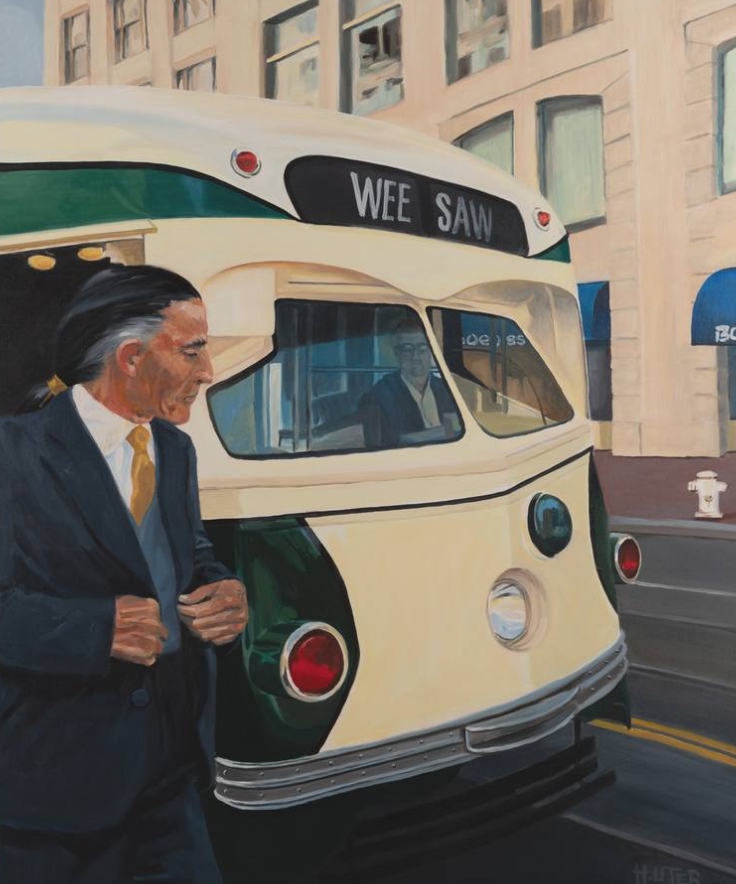Helen Uter’s Wee Saw (2001) is a captivating work of art that bridges the everyday with the imaginative, showcasing her distinctive narrative figuration style. Painted in oil on canvas, the artwork measures approximately 45.67 inches in height and 35.04 inches in width, commanding attention with its bold composition and evocative imagery. Uter, a Franco-American artist residing near Orléans, France, is celebrated for her ability to weave visual metaphors that blur the lines between reality and fiction.
An Artistic Playground: The Title’s Symbolism
The title Wee Saw immediately evokes a sense of whimsy and nostalgia, reminiscent of childhood and the innocence of discovery. At the same time, it plays on the duality of the seesaw as both a physical object and a metaphor for life’s ups and downs. This duality is a recurring theme in Uter’s body of work, where mundane elements are imbued with deeper existential questions.
In Wee Saw, Uter uses her characteristic painterly style to invite viewers into a narrative that unfolds through subtle details. Her Edward Hopper-inspired use of light and shadow creates an atmosphere of contemplation, as if the canvas itself is a pause in time.
Visual Narrative and Composition
The composition of Wee Saw features a balance of human figures and natural elements, unified through Uter’s warm, earthy color palette. Her meticulous brushwork and attention to detail ground the painting in realism, while abstract undertones add an air of mystery.
The interplay between the figures and their environment speaks to themes of connection and separation. Are the characters depicted as observers or participants in their world? This ambiguity is central to the painting’s allure, encouraging viewers to construct their own interpretations.
Influence of Edward Hopper
Uter’s admiration for Edward Hopper is evident in Wee Saw, particularly in her ability to capture the subtle emotional undertones of everyday life. Like Hopper, she employs quiet settings and solitary figures to explore themes of isolation and belonging in a modern world. However, Uter adds her own contemporary flair, incorporating symbolic elements that anchor her work in the 21st century.
Cultural and Personal Resonance
Wee Saw serves as more than just a visual experience—it is a narrative that resonates on both cultural and personal levels. The painting invites viewers to reflect on their own memories and experiences, connecting the universal with the intimate. For Uter, this ability to engage audiences in a shared dialogue is one of her greatest artistic strengths.
Helen Uter’s Broader Vision
Helen Uter’s oeuvre consistently explores themes of human connection, technology, and the natural world. Born in 1955, she has developed a unique visual language that reflects her Franco-American heritage and life experiences. Her works often depict ordinary moments transformed through her thoughtful use of symbolism and composition, encouraging viewers to look beyond the surface.
In Wee Saw, this vision is particularly clear. By transforming a simple scene into a layered narrative, Uter challenges us to find meaning in the everyday and recognize the beauty in life’s complexities.
The Legacy of Wee Saw
As one of Helen Uter’s notable works, Wee Saw continues to captivate collectors and art enthusiasts. It exemplifies her mastery of narrative figuration and her ability to evoke emotion through visual storytelling. Whether displayed in a gallery or a private collection, the painting serves as a reminder of the power of art to bridge worlds and inspire introspection.
For those drawn to Uter’s work, Wee Saw offers a glimpse into her artistic philosophy and her commitment to exploring the human condition. It is a painting that rewards careful observation, offering new insights with each viewing.
Helen Uter’s Wee Saw is a triumph of narrative art, combining technical skill with profound emotional depth. It invites viewers to step into a world of light, background, and meaning, challenging us to see the extraordinary in the ordinary.
No comments yet.








